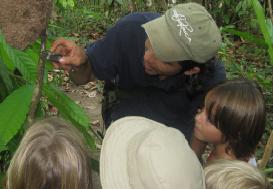[This article is a continuation of Education In Rural Costa Rica, Part 1]
Private School
Simply put, the reason most tico families do not send their children to private school is the cost. The best private elementary school in San Isidro runs around $275/month. Even by gringo standards this can be viewed as a lot of money; however, most parents understand the benefits are significant, like— bilingual studies, text books, well-equipped teachers and classrooms… to name a few. “After school” extra-curricular activities often include— art, dance, and sports. These creative activities teach kids so much more than memorizing dates in history. They prepare them for life beyond the farm, should they choose to pursue it.
To give you an idea of how “private schooling” has become synonymous with success, there are currently 6 public and 60 private universities in Costa Rica. The southern Pacific region is fortunate to have the Int. University San Isidro Labrador, only 45 minutes drive time from Dominical.[1] According to StateUniversity.com, “…higher education is free for nearly 50 percent of the enrolled students.” My guess is that scholarships are a significant part of the aforementioned $2 million (6.3%) of budgetary spending on education[2].
The task of the modern educator is not to cut down jungles, but to irrigate deserts.
– C. S. Lewis
Escuela Verde
The increase in private universities is a good sign for the future of the Costa Rica, but what about options for the parents of younger kids? Let me share a quick story about Escuela Verde, a new private grade school that opened in 2009 in Uvita. The school was founded by a couple of parents who were unimpressed by the public school options in the area, and their mission statement is clear,
“Escuela Verde prepares children to be resourceful and independent while inspiring them to give back to their multi-cultural community and the natural environment.”
After securing a building in Uvita Centro, they quickly rallied support from the parents and community. The teachers follow guidelines for Costa Rica and U.S. grade level guidelines, and many subjects are taught in both English and Spanish. Unlike many of the public schools, the kids are even responsible for completing regular homework assignments. They even have scholarships for tico families that want to expose their children to the best educational option available in the area. It is my understanding that they already have a long waiting list. For more information, you can go to Escuela Verde’s website.
A Melting Pot Of Ideas
Compared to crime and politics, education does not receive a lot of publicity in the media. However, it is a hot topic for parents who want to make Costa Rica their new home. Perhaps the best news I can offer our readers and potential clients is that the Southern Pacific Zone of Costa Rica is a melting pot, ala the United States of the 19th and 20th centuries. A blend of ideas, talents and energy has created a lively, international community… one that is keenly focused on sustainability, preservation, and education.
[1] http://education.stateuniversity.com/pages/300/Costa-Rica-HIGHER-EDUCATION.html#ixzz0ix0kJIPU
[2] http://www.ticotimes.net/dailyarchive/2008_09/090208.htm#story1

To give you an idea of how private schooling has become synonymous with success, there are currently 6 public and 60 private universities in Costa Rica. The southern Pacific region is fortunate to have the Int. University San Isidro Labrador, only 45 minutes drive time from Dominical.[1] According to StateUniversity.com, &higher education is free for nearly 50 percent of the enrolled students. My guess is that scholarships are a significant part of the aforementioned $2 million (6.3%) of budgetary spending on education[2].